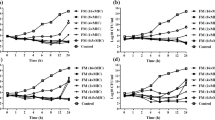Abstract
The in vitro activity of 17 antimicrobial agents was tested against 25 clinical isolates ofGardnerella vaginalis. Minimum inhibitory concentrations were determined by agar dilution. The isolates were sensitive to penicillin, ampicillin, ticarcillin, piperacillin, cephalothin, cefoxitin, cefotaxime, cefoperazone, N-formimidoyl-thienamycin, chloramphenicol, clindamycin and erythromycin. MIC90 for theβ-lactam antibiotics ranged from 0.12 mg/l for penicillin to 2 mg/l for ticarcillin. Cefoperazone was the most active cephalosporin, inhibiting all isolates at 1.0 mg/l. N-formimidoyl-thienamycin was the most active of the newerβ-lactam compounds inhibiting all isolates with a concentration of 0.5 mg/l. Clindamycin and erythromycin were highly active, inhibiting all isolates at 0.6 mg/l. Susceptibility to tetracycline, gentamicin, metronidazole and tinidazole varied between strains. All isolates were resistant to rosoxacin. The hydroxy-metabolites of metronidazole and tinidazole were more active than the parent compounds, inhibiting all isolates
Similar content being viewed by others
References
Gardner, H. L., Dukes, C. D.:Haemophilus vaginalis vaginitis. A newly defined specific infection previously classified “non-specific vaginitis”. American Journal of Obstetrics and Gynaecology 1955, 69: 962–976.
McCarthy, L. R., Mickelsen, P. A., Grover-Smith, E.: Antibiotic susceptibility ofHaemophilus vaginalis (Corynebacterium vaginale) of 21 antibiotics. Antimicrobial Agents and Chemotherapy 1979, 16: 186–189.
Dobson, R. A., O'Connor, J. R., Poulin, S. A., Kundsin, R. B., Smith, T. F., Came, P. E.: In vitro antimicrobial activity of rosoxacin againstNeisseria gonorrhoeae, Chlamydia trachomatis, andUreaplasma urealyticum. Antimicrobial Agents and Chemotherapy 1980, 18: 738–740.
Ralph, E. D., Austin, T. W., Pattison, L. M., Schieven, B. C.: Inhibition ofHaemophilus vaginalis (Corynebacterium vaginale) by metronidazole, tetracycline, and ampicillin. Sexually Transmitted Diseases 1979, 6: 199–202.
Ralph, E. D., Amatnieks, Y. E.: Metronidazole in treatment againstHaemophilus vaginalis (Corynebacterium vaginale). Antimicrobial Agents and Chemotherapy 1980, 18: 101–104.
Balsdon, M. J., Jackson, D.: Metronidazole metabolite andGardnerella vaginalis (Corynebacterium vaginale). Lancet 1981, i: 1112.
Shanker, S., Munro, R.: Sensitivity ofGardnerella vaginalis to metabolites of metronidazole and tinidazole. Lancet 1982, i: 167.
Hwang, M., Ederer, G. M.: Rapid hippurate hydrolysis method for presumptive identification of group B Streptococci. Journal of Clinical Microbiology 1975, 1: 114–115.
Bailey, R. K., Voss, I. L., Smith, R. F.: Factors affecting isolation and identification ofHaemophilus vaginalis (Corynebacterium vaginale). Journal of Clinical Microbiology 1979, 9: 65–71.
Greenwood, J. R., Martin, M. J., Mack, E. G.:Haemophilus vaginalis (Corynebacterium vaginale): method for isolation and rapid biochemical identification. Health Laboratory Science 1977, 14: 102–106.
Dunkelberg, W. E., Skaggs, R., Kellogg, D. S.: Method for isolation and identification ofCorynebacterium vaginale (Haemophilus vaginalis). Applied Microbiology 1970, 19: 47–52.
Durfee, M. A., Forsyth, P. S., Hale, J. A., Holmes, K. K.: Ineffectiveness of erythromycin for treatment ofHaemophilus vaginalis associated vaginitis: possible relationship to acidity of vaginal secretions. Antimicrobial Agents and Chemotherapy 1979, 16: 635–637.
Smith, R. F., Dunkelberg, W. E.: Inhibition ofCorynebacterium vaginale by metronidazole. Sexually Transmitted Diseases 1977, 4: 20–21.
Pheifer, T. A., Forsyth, P. S., Durfee, M. A., Pollock, H. M., Holmes, K. K.: Non-specific vaginitis. Role ofHaemophilus vaginalis and treatment with metronidazole. New England Journal of Medicine 1978, 298: 1429–1434.
Balsdon, M. J., Taylor, G. E., Pead, L., Maskell, R.:Corynebacterium vaginale and vaginitis: a controlled trial of treatment. Lancet 1980, i: 501–503.
Bardi, M., Manenti, G., Mattioni, D., Lasala, L.: Metronidazole for non-specific vaginitis. Lancet 1981, i: 1029.
Goei, S. H., Wells, J. I.:Corynebacterium vaginale in non-purulent vaginitis. Medical Journal of Australia 1981, 1: 470–472.
Malouf, M., Fortier, M., Moran, G., Duke, J. L.: Treatment ofHaemophilus vaginalis vaginitis. Obstetrics and Gynecology 1981, 57: 711–714.
Spiegel, C. A., Amsel, R., Eschenbach, D., Schoenknecht, F., Holmes, K. K.: Anaerobic bacteria in non-specific vaginitis. New England Journal of Medicine 1980, 303: 601–607.
Taylor, E., Blackwell, A. L., Barlow, D., Phillips, I.:Gardnerella vaginalis, anaerobes, and vaginal discharge. Lancet 1982, i: 1376–1379.
Author information
Authors and Affiliations
Rights and permissions
About this article
Cite this article
Shanker, S., Toohey, M. & Munro, R. In vitro activity of seventeen antimicrobial agents againstGardnerella vaginalis . Eur. J, Clin. Microbiol. 1, 298–300 (1982). https://doi.org/10.1007/BF02019975
Issue Date:
DOI: https://doi.org/10.1007/BF02019975




